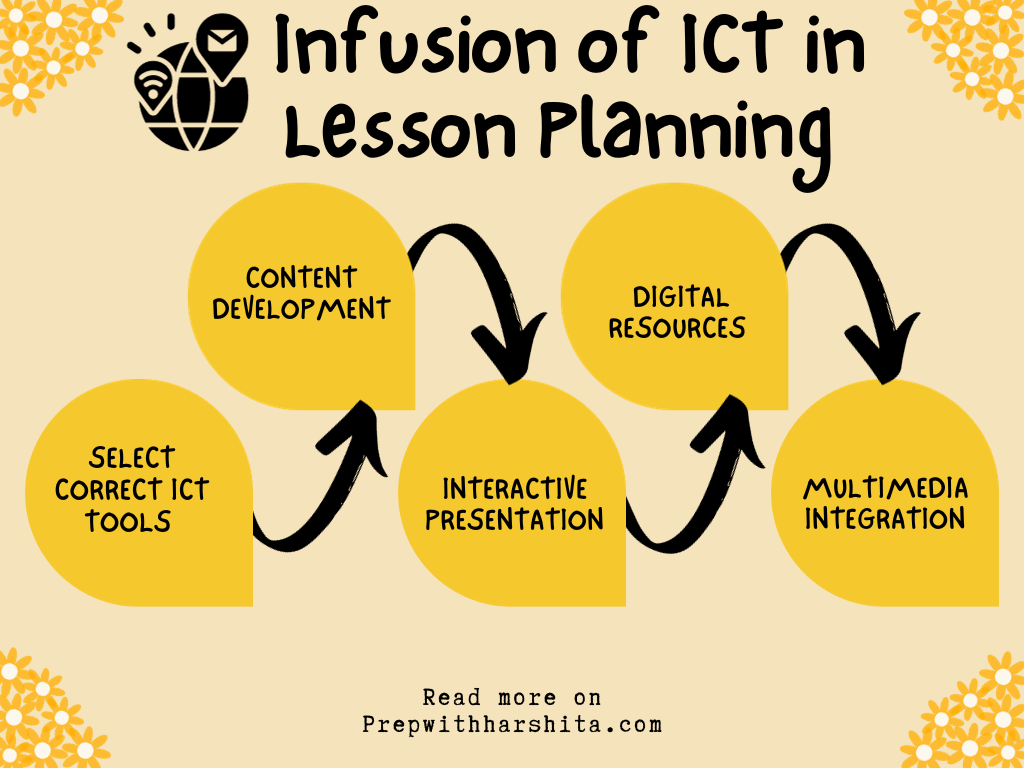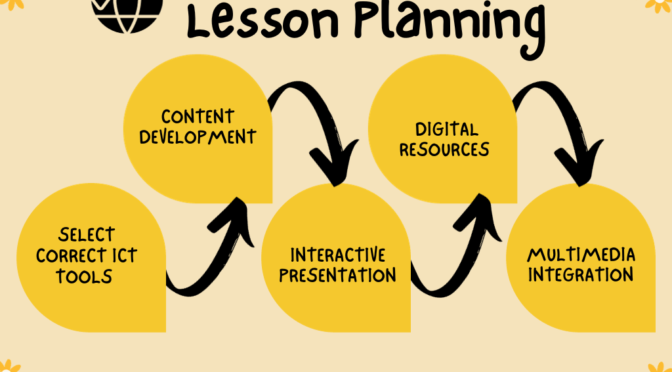Infusing ICT (Information and Communication Technology) into lesson planning is a detailed and systematic process that involves integrating digital tools, resources, and strategies into your teaching to enhance the learning experience.
Here’s a step-by-step guide on how to effectively infuse ICT into your lesson planning:
- Identify Learning Objectives:
- Start with clear and specific learning objectives. What do you want your students to learn or achieve by the end of the lesson?
- Start with clear and specific learning objectives. What do you want your students to learn or achieve by the end of the lesson?
- Select Appropriate ICT Tools:
- Identify ICT tools and resources that align with your learning objectives. These can include:
- Software and Applications: Choose educational software, apps, or online tools that support your lesson goals.
- Multimedia: Utilize images, videos, animations, and interactive multimedia to engage students.
- Websites and Online Resources: Incorporate relevant websites, e-books, articles, and databases for research and exploration.
- Learning Management Systems (LMS): Use an LMS to manage content, assignments, and assessments.
- Collaboration and Communication Tools: Employ platforms for discussions, group projects, and communication.
- Identify ICT tools and resources that align with your learning objectives. These can include:
- Content Development:
- Create or curate digital content that aligns with your lesson objectives. This may include presentations, e-learning modules, or multimedia resources.
- Create or curate digital content that aligns with your lesson objectives. This may include presentations, e-learning modules, or multimedia resources.
- Interactive Presentations:
- Use presentation software (e.g., PowerPoint, Google Slides, Prezi) to design engaging and visually appealing lesson materials. Incorporate multimedia elements to make the content interactive.
- Use presentation software (e.g., PowerPoint, Google Slides, Prezi) to design engaging and visually appealing lesson materials. Incorporate multimedia elements to make the content interactive.
- Digital Resources:
- Provide links to online resources that supplement the lesson. Ensure that these resources are credible, relevant, and accessible to students.
- Provide links to online resources that supplement the lesson. Ensure that these resources are credible, relevant, and accessible to students.
- Collaborative Learning:
- Foster collaboration among students using online discussion boards, group projects, and collaborative tools such as Google Docs or Microsoft Teams.
- Foster collaboration among students using online discussion boards, group projects, and collaborative tools such as Google Docs or Microsoft Teams.
- Assessment Tools:
- Incorporate digital assessment tools like online quizzes, surveys, and self-assessment activities for formative and summative assessments.
- Incorporate digital assessment tools like online quizzes, surveys, and self-assessment activities for formative and summative assessments.
- Adaptive Learning:
- Consider adaptive learning platforms that personalize content and assignments based on individual student needs and progress.
- Consider adaptive learning platforms that personalize content and assignments based on individual student needs and progress.
- Feedback Mechanisms:
- Use ICT tools for efficient and timely feedback. Learning management systems often offer features for automated grading and feedback.
- Use ICT tools for efficient and timely feedback. Learning management systems often offer features for automated grading and feedback.
- Monitoring and Analytics:
- Utilize data analytics and LMS dashboards to monitor student progress. Analyze the data to identify areas where students may need additional support or content adjustments.
- Utilize data analytics and LMS dashboards to monitor student progress. Analyze the data to identify areas where students may need additional support or content adjustments.
- Multimedia Integration:
- Integrate various multimedia elements like audio and video to cater to different learning styles and engage students visually and auditorily.
- Integrate various multimedia elements like audio and video to cater to different learning styles and engage students visually and auditorily.
- Virtual Labs and Simulations:
- In science and technical subjects, consider virtual labs and simulations that allow students to conduct experiments and practice skills in a virtual environment.
- In science and technical subjects, consider virtual labs and simulations that allow students to conduct experiments and practice skills in a virtual environment.
- Flipped Classroom Approach:
- Consider using ICT to deliver content outside of class, allowing in-class time for discussions, problem-solving, and collaborative activities.
- Consider using ICT to deliver content outside of class, allowing in-class time for discussions, problem-solving, and collaborative activities.
- Accessibility and Inclusivity:
- Ensure that all ICT tools and content are accessible to all students, including those with disabilities. Use technologies that offer features like closed captions, screen readers, and alternative formats.
- Ensure that all ICT tools and content are accessible to all students, including those with disabilities. Use technologies that offer features like closed captions, screen readers, and alternative formats.
- Professional Development:
- Teachers may need training and ongoing professional development to effectively use ICT in lesson planning. Many educational institutions offer workshops and resources for this purpose.
- Teachers may need training and ongoing professional development to effectively use ICT in lesson planning. Many educational institutions offer workshops and resources for this purpose.
- Continuous Improvement:
- Continuously evaluate the effectiveness of ICT integration in lesson planning. Collect feedback from students and use data analytics to make improvements.
- Continuously evaluate the effectiveness of ICT integration in lesson planning. Collect feedback from students and use data analytics to make improvements.
Also Visit: Prep with Harshita

Also Read: Resource Process in Educational Process

